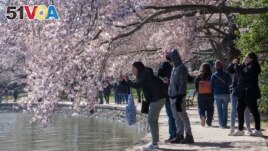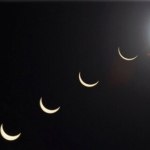18 March 2024
This year, the vernal equinox officially arrives on Tuesday, March 19 at 11:06 pm in Washington, D.C. That is 3:06 UTC on Wednesday, March 20. At that time, the sun will be exactly above the Earth's equator.
The word vernal comes from the Latin word vernalis, meaning "of the spring." And equinox comes from the Latin words aequus, meaning equal, and nox, meaning night. The day has 12 hours of daylight and 12 hours of nighttime.
And in the Northern Hemisphere, the day marks the beginning of spring.

FILE - People take photographs of cherry blossom trees that have begun to bloom, Monday, March 20, 2023, along the tidal basin in Washington, on the first day of the National Cherry Blossom Festival. (AP Photo/Jacquelyn Martin)
On this day, people living in colder areas of the Northern Hemisphere hope they can put away their winter clothes. They also may soon start planting flowers and vegetables in a garden.
Here in Washington, D.C., March 20 also marks the first day of the National Cherry Blossom Festival. Each year, people from around the world come to see the beautiful pink and white blossoms on the thousands of flowering cherry trees. For Washingtonians, the cherry blossoms are a welcome sign that spring has arrived.
In ancient times, some cultures built structures to signal the start of spring. Around the year 1000 A.D., for example, the Maya built a pyramid in what is now Mexico's Yucatan. It sits within an ancient city called Chichen Itza.
On the spring equinox, the sunlight hits in a way that makes the structure look like a snake. The Maya called this day "the return of the Sun serpent."
Today, cultures worldwide have their own ways of identifying and celebrating the arrival of spring.
Cherry blossoms
In Japan, spring is marked with a huge cherry blossom festival, known as hanami. The tradition dates back more than a thousand years. People gather under the blooming trees to eat, drink tea, celebrate and enjoy the cherry blossoms, known as sakura in Japanese. Artists and poets celebrate the short-lived blooms as a symbol of beauty.
In 1912, Japan gave 3,000 cherry trees to the U.S. capital city of Washington, D.C. The gift was to honor the lasting friendship between the United States and Japan.
Nowruz
For many countries in Central Asia and the Middle East, the vernal equinox also marks the beginning of a new year. The celebration is called Nowruz. The words "now" and "ruz" mean "new day" in Farsi.
Countries along the ancient Silk Road trading path, including Afghanistan, Iran, Turkey, Uzbekistan, and other Central Asian nations, celebrate Nowruz.
In the past, Iran was the only country where Nowruz was an official holiday. But after countries gained their independence following the fall of the Soviet Union, many made Nowruz a national holiday, as well.
During Nowruz, people visit family members and friends and exchange gifts. Iranian families set up a "haft seen" display of seven special items that represent spring and new beginnings.
In Uzbekistan and other places in Central Asia, people watch wrestling events, horse races and a special horseback game called, in Uzbek, Kopkari. In this game, two teams of players on horseback try to get the body of a headless goat into a goal. A similar game is called buzkashi in Afghanistan and oghlak tartish in Kyrgyzstan and Uyghur-speaking areas.
Holi festival
Many in India and Nepal mark the arrival of spring with the Holi festival, known also as the festival of colors or the festival of love.
This year, Holi will take place on March 25.
People celebrate the festival by covering each other in -- you guessed it -- colors! Children especially enjoy the festival, as they get to throw colored powder and water-filled balloons at others.
Some say the festival comes from a story of the burning of the devil Holika. It represents the victory of good over evil, or the arrival of spring after a long, dark winter.
Others say the celebration was inspired by the story of two young lovers with different skin colors. Krishna, who has blue skin, was in love with Radha. So, he colored Radha with paint leading to the modern-day colorful festival of love.
Las Fallas
People in Valencia, Spain, have their spring celebration called Las Fallas. It is a wild street festival involving fire.
The festival centers on the creation – and burning – of huge colorful statues made of wood, paper and plastic. The statues are meant to look like real people. Valencian communities and organizations work all year to create these structures and place them throughout the city, with fireworks inside.
Las Fallas celebrations began on March 15, with events like bullfights, parades, and cooking and beauty competitions. Then, at midnight on March 19, the city turns off all its streetlights and the statues are set on fire.
This marks the end of the festival and the beginning of spring.
I'm Ashley Thompson. And I'm John Russell.
Hai Do wrote this story for Learning English. Ashley Thompson was the editor.
What do people do to mark the beginning of spring where you live? Let us know! Write to us in the Comments Section or on 51VOA.COM.
_____
Words in This Story
serpent - n. a large snake
pyramid - n. a very large structure built especially in ancient Egypt that has a square base and four triangular sides which form a point at the top
blooming - adj. producing flowers
display - n. an arrangement of objects intended to decorate or inform people about something
powder - n. a dry substance made up of very tiny pieces of something










